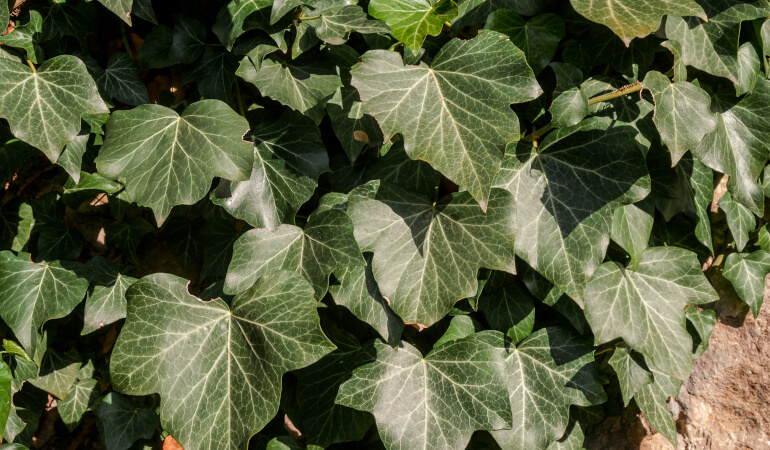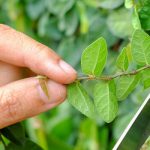
Evergreen climbers can add beauty and value to your garden, providing vivid colours all year round and enhancing privacy. By taking up minimal soil space and thriving in shady areas, they help you get the most out of your garden area. Not only do they look good all year round, but they can also attract beneficial wildlife into your outdoor space
In this blog post, we’ll reveal the top shade-loving evergreen climbers that grace the UK’s gardens, discussing their growth habits, care requirements, and the stunning visual impact they bestow upon any landscape.
So, prepare to be captivated by the lush foliage, delicate blooms, and the living artistry these climbers bring to shaded corners, reminding us that beauty flourishes even in the shadows.
Table of Contents
Best evergreen climbers that love shade
For those of you wondering what to plant in the shady areas of your gardens, we’ve created a collection of evergreen climbers that can easily thrive in low-light conditions. Perfect for walls, fences, pergolas, containers or even groundcovers these shade-loving climbers will surely make your outdoor area flourish once again.
Persian Ivy (Hedera colchica)

Persian Ivy, also known as Hedera colchica, features large, glossy, leathery leaves that are typically heart-shaped. This ivy produces small clusters of greenish-yellow flowers and blackberries, but its primary ornamental feature is its lush, dense foliage. It’s used for ground cover, climbing walls, or as a trailing plant.
This climber prefers moist, but well-draining soil that is fertile and rich in humus. Some examples of such types of soil are loam and clay soils.
Persian Ivy can tolerate partial to full shade. While it can grow in deep shade, it also handles some dappled or filtered sunlight. Protect it from the intense midday sun, especially in hotter climates to prevent damage.
English Ivy (Hedera helix)

English Ivy is another vigorous grower, well known for its trailing and climbing habits. Its leaves are dark green in colour with a glossy texture, often featuring pale-whitish veins.
Hedera helix produces small green-white flowers from September until November. The plant is commonly used for vertical gardens as it easily covers walls, fences and other structures.
English Ivy is adaptable to various light conditions, making it suitable for both shaded and partially sunny locations. It thrives in partial to full shade, but it can also tolerate some direct sunlight, especially in cooler climates. It prefers well-drained, fertile, and slightly acidic to slightly alkaline soil.
Seemann’s hydrangea (Hydrangea seemannii)

Hydrangea seemannii, also known as Seemann’s hydrangea, is a vigorous, evergreen climbing vine. It features leathery, oval to heart-shaped leaves that are dark green and glossy. The plant also produces beautiful clusters of fragrant, creamy-white flowers in late spring and early summer.
Seemann’s hydrangea can adapt to various soil types but thrives in well-drained, humus-rich, and slightly acidic to slightly alkaline soil. Keep the soil consistently moist during the growing stage of the plant. However, avoid overwatering.
The plant grows best in a partial to full shade. Some dappled sun won’t be an issue but avoid full sun exposure, especially in hotter regions, as it can lead to stress and sunburn.
Winter Creeper (Euonymus fortunei)

Winter creeper, or Euonymus fortunei, is a versatile evergreen ground cover and ornamental shrub. It features small, elliptical leaves with multi-coloured patterns, including green, white, and yellow, depending on the cultivar. It can be used as a ground cover, climbing vine, or shrub, depending on how it’s trained and maintained.
When it comes to the soil, Winter creeper prefers well-drained, fertile soil with a slightly acidic to slightly alkaline pH. It’s adaptable to different soil types, including loam and clay, but it benefits from regular moisture.
Euonymus fortunei can tolerate a range of light conditions, making it suitable for both full sun and deep shade. Its adaptability to different light conditions is one of its key strengths, making it a popular choice for landscaping.
Maidenhair vine (Muehlenbeckia complexa)

The Maidenhair vine has a delicate, fine-textured appearance and it’s often used for ground cover, hanging baskets, or as a climbing vine. It features wiry, interlacing stems with small, round, and bright green leaves. It can create an attractive, natural curtain effect when trained to grow over trellises and supports.
Maidenhair vine prefers well-draining, moderately fertile soil. Some of the soil types that the vine prefers are sandy and loamy. Maintain constant moisture, but make sure not to waterlog.
This plant thrives in full to partial sun but can tolerate light shade. While it prefers sunlight for optimal growth, it can adapt to some shade conditions. In hot climates, it may benefit from some shade during the hottest part of the day to prevent stress and leaf scorch.
Japanese Pachysandra (Pachysandra terminalis)

Japanese Pachysandra is a low-growing, evergreen perennial ground cover. It features dense, glossy, oval-shaped leaves that form a carpet-like mat and also produces small, inconspicuous flowers in the spring. The plant does not climb like a vine but is commonly used for ground cover in shady areas.
This evergreen beauty prefers well-drained, fertile soil and requires good soil moisture. Regular watering is essential, especially in dry conditions.
Japanese Pachysandra is well-suited to full shade or partial shade. It is known for its shade tolerance and can thrive in areas with minimal direct sunlight. The plant is a popular choice for planting under trees and in other shady areas where other plants struggle to grow.
Climbing Hydrangea (Pileostegia viburnoides)

Climbing Hydrangea is a vigorous, woody climbing vine. It features dark green, serrated leaves and produces large, fragrant white flowers in late spring to early summer. This vine is known for its ornamental qualities and can climb walls, fences or other structures, creating a striking visual display.
Climbing Hydrangea also grows best in a well-drained, fertile, and slightly acidic to slightly alkaline soil. Promote healthy growth by keeping the soil moist in the growing season.
The plant is best grown in partial to full shade. While it can tolerate some dappled sunlight or morning sun, it prefers protection from intense midday and afternoon sun. It’s advisable to provide some shade on really hot days if it’s exposed to direct sunlight to protect it from sunburn.
How to choose the right climber for your garden
Finding the most suitable evergreen climber for a shaded area demands careful consideration to make sure it prospers in its surroundings. To aid you with picking the perfect climbing evergreen for the dark areas of your green space, we will list some essential steps to follow:
- Shade levels – Assess the degree of shade in the area. Determine whether it is a light shade, partial shade or deep shade. Climbing plants vary in their tolerance to shade, so understanding the specific conditions that the plant requires will help you with your choice.
- Light exposure – Observe how much natural light the shaded area receives throughout the day. Some evergreen climbers can tolerate dappled light, while others may require at least a few hours of indirect sunlight to maintain their lush foliage.
- Growth habit and support – Consider the growth habit of the climbing plant and the type of support it requires. Some climbers, like Ivy, cling to walls using adhesive pads or aerial roots, while others use twining stems that need a trellis or other supportive structure.
- Structure size and space – Determine the available space and the size of the structure you want the evergreen climber to cover. Ensure the chosen plant is well-suited for the area without overwhelming it.
- Year-round foliage – Since you’re seeking an evergreen climbing plant, check that it actually retains its foliage throughout the whole year. The presence of lush green leaves during the winter months will add colour and vibrancy to the shaded area.
- Climate suitability – Ensure the chosen climbing evergreen is suitable for your specific zone and local climate. Consider the temperature extremes and weather conditions it might encounter.
- Care and maintenance – Research the care requirements of the climbing plant you are interested in. Some evergreens might need minimal pruning and maintenance, while others may require specific soil conditions or feeding.
Some planting tips for evergreen climbers
So, let’s say you’ve already chosen a specific evergreen climbing plant for your garden. Now it’s time to plant it. The following tips will save you a lot of time and stress, as they provide valuable information on exactly what you need to be aware of when planting an evergreen climbing plant.
- Prepare the planting site – Ensure the planting area has well-draining soil and is free from weeds. Loosen the soil and add compost to improve the soil fertility and water retention.
- Planting hole – Dig a planting hole that is at least twice as wide as the climber’s root ball and slightly shallower than the container’s depth. By doing so, you will encourage root spread.
- Support and structure – Install a trellis, arbour, or other suitable support structure for the climber to grow and cling to. Don’t forget to ensure the structure’s sturdyness and capability to handle the weight of the mature plant.
- Planting depth – Place the evergreen climber in the centre of the hole and backfill with soil, making sure the top of the root ball is levelled with the surrounding soil. Avoid planting too deeply, as this can suffocate the plant’s roots.
- Watering – Water the newly planted climber thoroughly to settle the soil and promote root establishment. Keep the soil consistently moist during the first growing season to support healthy growth.
- Mulching (Optional) – Apply a layer of organic mulch around the base of the plant, but avoid piling it up against the stem. Mulch helps retain moisture, suppresses weeds, and maintains a more stable soil temperature.
- Pruning – Regularly prune evergreen climbers to manage their growth and shape. Pruning also encourages new growth and flowering. Follow the specific pruning guidelines for your chosen climber.
- Fertilisation – Feed evergreen climbers with a balanced, slow-release fertiliser in the spring and early summer to provide essential nutrients for healthy growth and vibrant foliage.
- Disease and pest control – Monitor your evergreen climbers for any signs of pests or diseases. Early detection can help prevent potential issues from spreading and affecting the plant’s health.
- Winter protection – In colder regions, consider protecting the evergreen climbers during winter. Mulch around the base and consider covering the plant with burlap or frost cloth to shield it from the cold.
- Training and support – As the evergreen climber grows, guide its tendrils or stems along the support structure to encourage proper growth and prevent tangling.
- Regular inspections – Periodically inspect the plant for signs of stress, disease, or damage. Address any issues promptly to maintain the climber’s health and appearance.
Are you still struggling with choosing the right climber for your garden? Get in touch with Fantastic Gardeners today!
Enter your postcode to view our rates and availability in your area.
For questions about the services we offer visit our main site
Takeaways:
- Planting an evergreen climber can further improve the privacy of your garden and bring colour all year round.
- Take some time to decide on a spot for your evergreen climber and choose a type of plant that will thrive in your desired location.
- Make sure you research well the behaviour of the evergreen climber you like and the care you will have to provide, as some species may not be as low-maintenance as you expect and could show invasive behaviour.
- When planting the climber, provide it with a good amount of water in order to support root growth.



